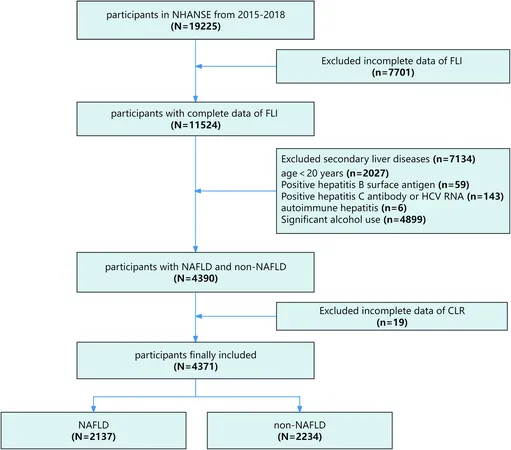
Unlocking the Mysteries of C-Reactive Protein and Lymphocyte Ratios in NAFLD: Insights on Mortality Risks
2025-05-01
Author: Wei Ling
Understanding the Study: C-Reactive Protein and NAFLD
Recent research dives deep into the relationship between C-reactive protein (CRP) to lymphocyte ratio (CLR) and non-alcoholic fatty liver disease (NAFLD). Based on thorough analysis from the National Health and Nutrition Examination Survey (NHANES), this study sifts through data from thousands of participants to unveil critical health connections.
Who Participated?
The study focused on data collected from nearly 20,000 individuals across two NHANES cycles (2015-2016 and 2017-2018). After meticulous filtering—removing incomplete data, individuals under 20, and those with other liver conditions—about 4,371 participants were assessed. Mortality data were tracked until the end of 2019 to probe the impact of CLR on overall health outcomes.
CRP and Lymphocyte Ratios: Key Measures
CRP levels were analyzed using sophisticated lab methods, while lymphocyte counts came from precise cell counting techniques. The CLR, an innovative metric combining inflammation and immune response, was computed to gauge its potential implications for NAFLD.
Decoding NAFLD: The Fatty Liver Index
NAFLD was primarily identified using the Fatty Liver Index (FLI)—a formula incorporating triglyceride levels, body mass index, and waist circumference, among other factors. The study defined NAFLD when FLI values hit 60 or above, minus cases influenced by viral hepatitis or substantial alcohol use.
What Did We Find? Key Findings on Mortality and CLR
The investigation concluded that while CLR correlates significantly with the risk of developing NAFLD, it did not showcase a direct impact on all-cause or cardiovascular mortality risk among NAFLD patients. This information was gleaned over a median follow-up period of nearly three years.
Rising CLR: An Unfolding Relationship?
The study indicated a fascinating nonlinear relationship; as CLR rises, so does the risk of NAFLD—but only up until a point, suggesting a potential threshold effect where extremely high CLR levels may no longer escalate risks.
Delving Deeper: Subgroup Insights
Delving into subgroup analyses, the data showed CLR's impact on NAFLD was notably pronounced in individuals without dyslipidemia, highlighting intriguing dynamics between lipid levels and inflammatory responses in the body. This suggests that metabolic health plays a crucial role in how inflammation manifests in liver-related diseases.
Implications of Findings: Why They Matter
This comprehensive analysis is the first to directly link CLR with NAFLD while exploring its effects on mortality. Although inflammation markers like CRP have previously been associated with liver health, CLR emerges as a critical gauge of systemic inflammation and immune status.
Looking Ahead: Future Research Directions
While these findings are groundbreaking, they underscore the need for additional studies linking CLR to liver-specific mortality. Future investigations are essential to confirm these associations and better understand the intricate web of factors influencing NAFLD.
Conclusion: A Crucial Study for Liver Health Insights
In summary, this research not only sheds light on the potential role of CLR in the assessment of NAFLD but also highlights the need for further exploration of liver health nuances. As we seek to unravel the complexities of NAFLD, understanding inflammation's nuances will be key in enhancing patient care and outcomes.



 Brasil (PT)
Brasil (PT)
 Canada (EN)
Canada (EN)
 Chile (ES)
Chile (ES)
 Česko (CS)
Česko (CS)
 대한민국 (KO)
대한민국 (KO)
 España (ES)
España (ES)
 France (FR)
France (FR)
 Hong Kong (EN)
Hong Kong (EN)
 Italia (IT)
Italia (IT)
 日本 (JA)
日本 (JA)
 Magyarország (HU)
Magyarország (HU)
 Norge (NO)
Norge (NO)
 Polska (PL)
Polska (PL)
 Schweiz (DE)
Schweiz (DE)
 Singapore (EN)
Singapore (EN)
 Sverige (SV)
Sverige (SV)
 Suomi (FI)
Suomi (FI)
 Türkiye (TR)
Türkiye (TR)
 الإمارات العربية المتحدة (AR)
الإمارات العربية المتحدة (AR)